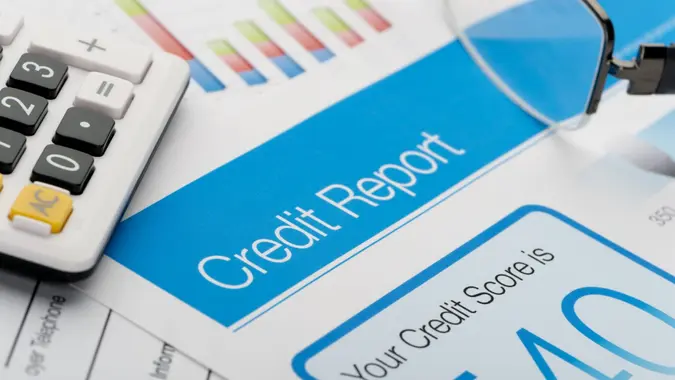How To Turn Bad Credit Into Good Credit in 60 Days, According To Experts

Commitment to Our Readers
GOBankingRates' editorial team is committed to bringing you unbiased reviews and information. We use data-driven methodologies to evaluate financial products and services - our reviews and ratings are not influenced by advertisers. You can read more about our editorial guidelines and our products and services review methodology.

20 Years
Helping You Live Richer

Reviewed
by Experts

Trusted by
Millions of Readers
Bad credit can wreak havoc on so many aspects of your financial life. It can stand in the way of your buying a home, leasing a car or even renting an apartment. Once you have bad credit, it can be tough to build it back up, but there are 10 ways to do it rather quickly, according to a number of experts.
Here’s how to turn bad credit into good credit in just 60 days.
Get a Secured Credit Card
Getting a secured credit card can help you build up a positive payment history. This can be crucial in helping you quickly improve your credit score.
“How quickly the card will result in improvements in your score depends on how low your score has dropped,” Dr. Enoch Omololu, MSc, Econ, founder of Savvy New Canadians. “However, you can start to see improvements in as little as 60 days if you use the secured credit card responsibly and make payments on time.”
Also good news is the fact that secured credit cards are easy to qualify for “even if you have bad credit, since you provide a deposit to the credit card company, which becomes your credit limit,” Omololu said. “If you default on payments, the credit company is protected.”
Prioritize Paying Off Debt
Credit card debt typically comes with steep interest fees, which can be a hurdle to pay down, because that interest just keeps accumulating. It’s essential to tackle this debt ASAP. You can do this in a couple ways.
“Two methods I recommend if you want to manage multiple debt lines at once without consolidating are the snowball and avalanche methods,” Omololu said. “The debt snowball method focuses on paying off the smallest balances first to work through your debt.”
“The avalanche method focuses on paying off the highest interest first, which can help you save more in the long run,” Omololu said. “While this might sound advantageous, it does require more due diligence from the start and a firm budget. Conversely, the snowball method can be excellent for those motivated by little wins that will help you stay the course to pay off a higher debt balance.”
Dispute Credit Report Errors
Mistakes happen, even on your credit report. Be sure to scour yours for any errors on a regular basis.
“It’s important to regularly check your credit reports for any errors and dispute them with the appropriate credit bureaus,” said Joshua Richner, marketing director at National Legal Center. “Inaccuracies on your report could be costing you points, so make sure to take the time to review it for potential issues.”
Don’t Miss Payments
Did you know that just one missed credit card payment can do damage to your credit score? Be vigilant around this and set up auto payments to take some of the mental load off.
“When trying to improve your credit score, the last thing you want to do is miss a payment,” Omololu said. “Make a budget that prioritizes paying the minimum — or ideally the full balance — payment on your credit card each month. This is the best thing to do to help improve your score quickly and keep it stable in the long term. Your payment history carries a 35% weight when calculating your credit score.”
Make Payments Twice a Month
If possible, aim to make payments on debt — especially credit card debt — twice a month.
“This is an excellent strategy to increase your credit score to the desired level,” said Loretta Kilday, Debt Consolidation Care spokesperson. “You’ll also establish a new habit to help maintain it there. Nothing prevents you from making additional payments to your debt more frequently than once each month. Every time you receive a paycheck, pay what you can and watch your amounts decrease as your credit score rises.”
Keep Your Credit Use Under 30%
Your credit utilization is the ratio of your available credit to your current credit usage. It’s wise to keep this as low as possible.
“Maintain your credit utilization as low as you can for the best results on your credit,” said Kilday. “Even if it might not always be possible, you should strive to limit your credit utilization to 30% or below.”
Don’t Apply for Too Many New Lines of Credit in a Short Period of Time
It’s so easy to apply for credit cards, but you must avoid the temptation when trying to clean up your credit.
“Too many applications in a short window will significantly lower [your score], especially if the applications are declined,” Richner said. “Hard inquiries — how credit is checked when you apply for a line of credit — are a part of your credit history. Each one can cost you several points and can stay on your report for up to two years.”
Ask for an Increase in Available Credit
Increasing your available credit can actually help lower your utilization rate.
“Doing this helps make you appear as a responsible borrower in the eyes of your credit card company,” said Omololu.
Don’t Close Credit Cards
When you’re tackling debt, it may seem intuitive to close credit cards. Paradoxically, this can actually cause more trouble for your credit situation.
“You want to avoid doing this, as the length of your credit history is another factor that influences your score,” said Omololu. “Having older lines of credit still open but utilizing them smartly can actually help benefit your score as you work to repair it.”
Use a Credit-Building Tool
If you have poor credit, you might want to consider enlisting the help of a credit-building product, such as CreditStrong. For example, CreditStrong’s Revolv tool helps you build up your credit score without the risk of going into debt. This tool basically asks you to commit to contributing a certain amount to a savings account each month, and those monthly deposits get reported to the credit bureaus as if they were credit card payments.
More From GOBankingRates
- Nearly 1 in 3 Americans Hit by a Costly Holiday Scam, Norton Survey Shows -- How To Avoid This
- Here's What the Average Social Security Payment Will Be in Winter 2025
- How Middle-Class Earners Are Quietly Becoming Millionaires -- and How You Can, Too
- The Easiest Way to Score $250 for Things You Already Do
 Written by
Written by  Edited by
Edited by 























